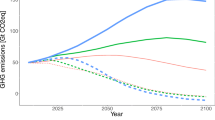Abstract
Although international negotiation on the mitigation of climate change is a process of determining burden-sharing rules between countries, there has been no clear agreement on equity principles for burden sharing. During the negotiating process up to the Kyoto Protocol, various proposals were made on such burden-sharing rules, but an agreement on emission targets for Annex I countries was achieved without explicitly agree-ing to any rules. In the next phase of the negotiation, debates on emission targets are likely to shift from those between developed countries to those between all parties to the convention. In such a phase, debates on burden-sharing rules will be revisited. The purpose of this paper is: (1) to determine implicitly a formula for the rule for burden sharing between Annex I countries that was considered to be underlying the emission targets of the Kyoto Protocol, and (2) to examine plausible emission targets and timing of commitments for non-Annex I countries in the future by using the result of the analysis on the Kyoto Protocol. A multi-regression method is used for this purpose. It was concluded that the burden sharing between Annex I countries in the Kyoto Protocol can mostly be explained by three variables: the increase in the rate of CO2 emission during the years 1990 to 2010, the increase in the rate of afforestation between 1990 and 1995, and the GDP per capita at the time of negotiation. The timing of future commitments of developing countries and the levels of targets differ widely, depending on which index or formula is agreed as “equitable”. Some of the developing countries would have to start limiting their emissions within several years if GDP per capita or CO2 per capita were chosen as the burden-sharing indicator. Developing countries would not have to make commitments until the mid-late 21st century if population growth rate were chosen. If the inferred formula of the Kyoto Protocol were applied to developing countries, they would have had to start mild limitation from 1990.
Similar content being viewed by others
References
AIM Project Team (1996) AIM interim paper, IP-95-05. Tsukuba
Carbon Dioxide Information Analysis Center (1998) Revised national CO2 emission from fossil-fuel burning, cement manufacture, and gas flaring: 1751–1995; http://cdiac.esd.ornl.gov/ftp/ndp030/
Claussen E, McNeill L (1998) The complex elements of global fairness. Pew Center on Global Climate Change, Washington, DC
IEA/OECD (1998a) Energy balances of OECD countries, 1995–1996. IEA/OECD, Paris
IEA/OECD (1998b) Energy balances of non-OECD countries, 1995–1996. IEA/OECD, Paris
Intergovernmental Panel on Climate Change (IPCC) (2000) Emissions scenarios. Cambridge University Press, Cambridge
Kawashima Y (1996) The possibility of differentiating targets: indices and indexing proposals for equity. In: Report of a workshop held at the Royal Institute of International Affairs. Royal Institute of International Affairs, London, pp 61–70
Ringius L, Torvanger A, Holtsmark B (1998) Can multi-criteria rules fairly distribute climate burdens? OECD results from three burden-sharing rules. Working paper. CICERO, Oslo, p 6
Rose A, Stevens B (1993) The efficiency and equity of marketable permits for CO2 emissions. Resource Energy Econ 15: 117–46
Smith K (1993) The basics of greenhouse gas indices. In: Hayes P; Smith K (eds) The global greenhouse regime: who pays? UNU Press Earthscan, London, pp 20–49
United Nations (1995) Statistical yearbook 1993, 39th issue. United Nations, New York
United Nations (1997a) Statistical yearbook 1995, 42nd issue. United Nations, New York
United Nations (1997b) UN Document FCCC/AGBM/1997/2. 31 January 1997. United Nations, NewYork, pp 39–45
United Nations (1998) UN document FCCC/CP/1998/11/Add.2. United Nations, New York
World Bank (1996) World population projections 94/95 year 1990–2150. World Bank, Washington, DC
World Bank (1999) web site http://www.worldbank.org/data/databytopic/databytopic.html
Author information
Authors and Affiliations
Corresponding author
Rights and permissions
About this article
Cite this article
Yanagi, M., Munesue, Y. & Kawashima, Y. Equity rules for burden sharing in the mitigation process of climate change. Environmental Engineering and Policy 2, 105–111 (1999). https://doi.org/10.1007/s100220000028
Received:
Published:
Issue Date:
DOI: https://doi.org/10.1007/s100220000028




